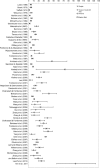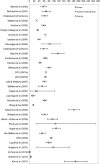Global prevalence of autism and other pervasive developmental disorders
- PMID: 22495912
- PMCID: PMC3763210
- DOI: 10.1002/aur.239
Global prevalence of autism and other pervasive developmental disorders
Abstract
We provide a systematic review of epidemiological surveys of autistic disorder and pervasive developmental disorders (PDDs) worldwide. A secondary aim was to consider the possible impact of geographic, cultural/ethnic, and socioeconomic factors on prevalence estimates and on clinical presentation of PDD. Based on the evidence reviewed, the median of prevalence estimates of autism spectrum disorders was 62/10 000. While existing estimates are variable, the evidence reviewed does not support differences in PDD prevalence by geographic region nor of a strong impact of ethnic/cultural or socioeconomic factors. However, power to detect such effects is seriously limited in existing data sets, particularly in low-income countries. While it is clear that prevalence estimates have increased over time and these vary in different neighboring and distant regions, these findings most likely represent broadening of the diagnostic concets, diagnostic switching from other developmental disabilities to PDD, service availability, and awareness of autistic spectrum disorders in both the lay and professional public. The lack of evidence from the majority of the world's population suggests a critical need for further research and capacity building in low- and middle-income countries.
© 2012 International Society for Autism Research, Wiley Periodicals, Inc.
Figures
References
-
- Al-Farsi Y, Al-Sharbati M, Al-Farsi O, Al- Shafaee M, Brooks D, Waly M. Brief report: prevalence of autistic spectrum disorders in the Sultanate of Oman. 2010. - PubMed
-
- Al-Salehi SM, Al-Hifthy EH, Ghaziuddin M. Autism in Saudi Arabia: presentation, clinical correlates and comorbidity. Transcultural Psychiatry. 2009;46:340–347. - PubMed
-
- American Psychiatric Association. Diagnostic and statistical manual of mental disorders. 3rd ed. Arlington, VA: American Psychiatric Association; 1980.
-
- American Psychiatric Association. Diagnostic and statistical manual of mental disorders. 3rd ed. Arlington, VA: American Psychiatric Association; 1987. Revised.
Publication types
MeSH terms
Grants and funding
LinkOut - more resources
Full Text Sources
Other Literature Sources
Medical



